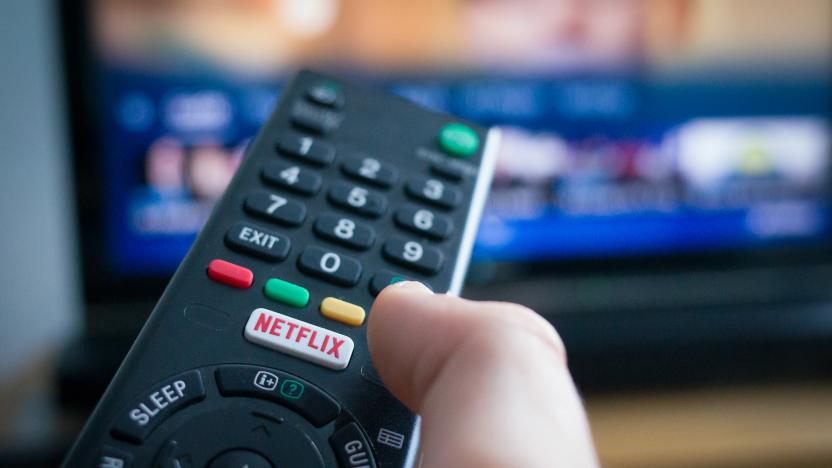codec
Latest

Netflix enables its bandwidth-saving AV1 codec on PS4 Pro and select TVs
Netflix says AV1 delivers better video quality and uses lesser bandwidth than the codecs it's currently using.

New H.266 codec uses half the data to stream 4K video
Fraunhofer, the German company that helped develop the H.264, H.265 and MP3 encoding formats, has unveiled a new video encoding standard that could severely reduce streaming bottlenecks. Called H.266/Versatile Video Coding (VVC), it’s specifically designed for 4K and 8K streaming and reduces data requirements by around 50 percent compared to H.265 HEVC (high-efficiency video coding).

Apple brings ProRes RAW support to Windows video editors
Thanks to a combination of more affordable cinema cameras and increasingly powerful software, professional video producers are able to net some impressive results. One major part of the equation for achieving high-quality footage is shooting in a RAW codec, which creates lossless files that are suitable for color correction and other enhancements. Apple's ProRes RAW codec isn't a very popular choice among shooters, but that may change now that the format isn't exclusive to Apple's computers. The company released beta software that lets Windows editors work with ProRes RAW files in Adobe's Premiere Pro, After Effects and Media Encoder. This means they won't have to devote time or computing power to transcoding the files -- they can simply load them into their editing suite and get to work.

Netflix switches to the AV1 codec for data-saving streams on Android
Way back in 2015 Netflix announced it would team up with Amazon, Google, Intel and other companies to develop a royalty-free codecs that worked well on modern devices. Two years ago they revealed the fruits of their labor as the AV1 codec, that promised not only freedom from licensing payments they wanted to avoid, but also a saving of up to 30 percent on the amount of data used to stream 4K HDR video. Now, Netflix has started using AV1 on a "select" set of titles, and only for users on Android who've enabled the "Save Data" feature.

Blackmagic's RAW video codec marries quality and speed
Following in the footsteps of Apple's ProRes RAW, Blackmagic Design has launched its own RAW video codec into a public beta. Blackmagic RAW "combines the quality and benefits of RAW with the ease of use, speed and file sizes of traditional video formats," the company says. It arrives today on Blackmagic's URSA Mini Pro cameras (in beta) and DaVince Resolve 15.1, and developers can grab the SDK for macOS, Windows and Linux.

aptX Adaptive Bluetooth audio delivers low latency and high quality
As headphone jacks continue to disappear, wireless options for audio are becoming more important than ever. In 2015, Qualcomm acquired the aptX codec for Bluetooth audio connections, and currently offers technology as a pair of extended flavors: aptX HD for "better-than-CD high definition sound quality" and aptX low latency tech keeps things in sync for video or gaming applications. Today it's announcing aptX Adaptive which takes a "why not both?" approach suitable for the way most of us live now, playing different types of media across multiple devices and environments including VR and mixed reality.

Apple brings RAW video editing to the masses with new FCP X update
Apple has unveiled a new video recording codec called ProRes RAW, a move that instantly makes the high-quality format more mainstream. The feature arrived with the latest version of Final Cut Pro (10.4.1), and Apple said that creators will be able to use it right away via updates to DJI's filmmaking drones and Atomos recorders. "With ProRes RAW, editors can import, edit and grade pristine footage with RAW data from the camera sensor, providing ultimate flexibility when adjusting highlights and shadows -- ideal for HDR workflows," said Apple.

Tech giants are lined up behind the 'royalty-free' 4K codec AV1
Usually, when a new video compression scheme arrives it takes so long before there's a combination of compatible hardware and content that its arrival is anticlimactic. Google, Apple, Netflix, Microsoft, Intel, Amazon and a host of other companies have taken steps to make sure AOMedia Video Codec 1.0 (AV1) moves a bit faster, and for several good reasons. Today they're teaming up to announce the release of a 1.0 specification for AV1, and get the ball rolling on support for video creation, distribution and playback with the new format. With AV1, the group promises it can deliver 4K UHD video using 30 percent less data. That's great for high-res streams and should provide plenty of savings even for those on older hardware -- expect faster video startup time, less buffering and better picture quality.

Apple joins group pushing for efficient mobile video
As streaming video becomes more ubiquitous on all every platform, it's even more important that we get some sort of standard for scalability across devices and bandwidth. The Alliance for Open Media is an open-source project that has engaged a ton of tech heavy hitters to get together and figure out how to create a next-gen video format that can do just that. As noted by CNET, Apple has just joined the Alliance at a founding (board) member tier. Engadget checked archive.org and confirmed Apple's inclusion in the list sometime in the past week. We've reached out to Apple and will update this post if we hear back.

Here's how YouTube is making it easier to watch 4K video
It's one thing to find 4K video, but it's another thing to play it -- the bandwidth needed to play high-quality 4K video could easily crush many home internet connections, let alone your mobile service. YouTube isn't taking that challenge lying down, though. As the service explains, it has been encoding many videos in its newer VP9 format in recent months to make 4K more viable and improve the picture you see. The codec uses as little as half the bandwidth as the H.264 standard you see on many parts of the web, even as it bumps up the image quality by prioritizing sharp features and taking into account fast-moving elements in the footage, like water spray.

VLC for Mac gets 4K support, dozens of new features including G2M4 playback
The VideoLan Organization has released a major update to the VLC media player for OS X and Windows. VLC 2.1 adds a number of significant updates to the popular open-source media player. For starters, VLC now supports "Ultra HD video," otherwise known as 4K. That means VLC is now capable of outputting video at more than twice the resolution of Blu-ray. This, of course, requires that you have source video files of 4K quality. In addition to 4K support, VLC 2.1 now also offers OpenGL ES, which will make outputting video to iOS and Android devices much easier. The update has also added support for more than a dozen other video codecs. And that's just the tip of the iceberg. VLC 2.1 offers dozens more new features in all areas including audio, formats, inputs, mobile and for developers. On top of all the new features, more than 1,000 bugs were also fixed. For one group of Mac users, the new VLC offers a potential solution to a longstanding pain point. Citrix's GoToMeeting web conferencing platform does a nice job of recording presentations for later review, but recordings made with the default settings in the company's Windows client use a proprietary codec (G2M4) to save space and bandwidth. With no way to play these encoded videos on a Mac, G2M users have resorted to elaborate re-encoding schemes to render the files accessible. There's now light at the end of the G2M4 tunnel; VLC 2.1 lists compatibility with the codec among its new features, so Mac users should be able to play the encoded files without a problem. VLC 2.1 is a free download.

Sony announces Long GOP 4K codec for pros, XAVC-S for consumers
If you were chomping at the bit to create content for the oncoming 4K revolution, Sony has just announced a couple of enhancements to its XAVC video format to help you on your way. Long GOP is a high-efficiency codec designed to meet the requirements of the professional market, while XAVC-S is aimed squarely at consumers with its MP4 wrapping. Of course, both codecs should play nice with Sony's series of CineAlta cameras (the PMW-F5 is pictured above), which is set to reach over 2,000 units shipped by the end of the month. Sony's not the only one making XAVC-compatible devices however; over 60 manufacturers have applied for XAVC licenses while 31 others have pledged to support it in their products. Seeing as 4K hardware is finally dipping into affordability, we can't fault Sony for getting the ball rolling, at least from the creation side of things.

Nokia accuses Google of 'forcing' VP8 video codec on the world, uses patent system to resist it
Just when Google thought everything was going swell with its open source VP8 video standard for the web, up pops one last hurdle. And it's a big one: Nokia has suddenly decided to use the patent system to try to prevent VP8 from being adopted as a free (or at least free-er) alternative to the license-laden H.264. Why would it do such a thing? Because, according to a statement given to FOSS Patents, the Finnish manufacturer believes VP8 isn't truly open. It describes the codec as a "proprietary technology" that offers "no advantages" over H.264 and that Google is "attempting to force" on others as part of its WebM project. What's more, Nokia claims VP8 infringes on its own intellectual property and says it isn't prepared to license any patents that may be required to let VP8 flourish. Oh dear. This problem may now need even more money thrown at it.

Google and MPEG LA settle up, free VP8 video codec for the world wide web
The longstanding disagreement between Google and MPEG LA is finally over, as the two parties have reached a licensing agreement for several patents covering video compression. As a quick refresher, MPEG LA owns the technology behind h.264, the current king of video codecs. Meanwhile, Google's own VP8 video codec is a part of its WebM standard, but MPEG LA cried foul, claiming that Google's technology was infringing. Apparently, the companies found common ground, and with the settlement in place, WebM is free from patent encumbrances and video producers can do what they do without fear of legal retribution.

ITU approves the H.265 video format, takes us closer to high-quality mobile video
Any smartphone owner who's ever watched a streaming HD video buffer... and buffer... and buffer on even LTE connections will appreciate the ITU's speediness today. Just months after MPEG proposed the extra-miserly H.265 video codec, the ITU has approved it as an official standard. As it's greenlit so far, the format (also known as High Efficiency Video Coding) includes 8-bit, 10-bit and photo-oriented profiles that should cover most 2D capture and playback. Pros are promised 12-bit and chroma profiles in the future, while there's work on 3D for all of us. We'll have to wait for both software support and hardware acceleration to reap the rewards, but there should be many: the halved bandwidth requirements have obvious benefits for cellular devices as well as 4K media delivery for that rash of giant TVs about to hit the market. Let's hope that camera and mobile device makers are just as impatient as we are.

University of Bath develops efficient vector-based video, says pixels are old hat
The pixel does the job for most digital imagery -- it sure makes for a fine shirt -- but it's not so hot for video, where growing resolutions chew up gobs of bandwidth. There may be a wiser strategy coming from the University of Bath, whose researchers have developed a more efficient approach to movie codecs. Their new format uses vectors to render footage with colored contours that demand fewer resources than a dot-by-dot approach. While vector-based rendering isn't original in itself, the researchers' method is supposedly unique in filling the gaps between the contours with the kind of visual quality a pro videographer would crave. The university team is confident enough that it's talking to major companies about using the codec for post-production tools, and sees it spreading to mobile devices where connection speeds and storage are at a premium. It could take years for vector-based video to catch on; if the technology ever upsets the pixel's reign, though, more than a few Vectrex owners may see it as poetic justice.

Sony to release XAVC 4K video spec, licensees include Apple, Adobe
Sony has announced that it'll release an SDK to 4K developers this month for its recently launched XAVC video format used by the new F5 and F55 CineAlta camcorders. The new specification uses MPEG-4 AVC/H.264 video compression, which allows up to 12-bit color depth, 60 fps shooting speed at 4k and 180 fps in HD. So far, fourteen companies including Adobe and Apple have signed on as licensees, and Sony says the format may come to consumer products as well. Details of the program along with an SDK will arrive this month, just in time for a possible Ultra HD onslaught.

Skype promising CD quality sound from new 'Opus' audio codec, fewer choppy calls
Skype's got a new audio codec that it thinks you should be pumped about, and it's called "Opus." It's been kicked around at Skype since March 2009, though work didn't begin in earnest until June of the same year, and it was just certified by the IETF as a standard of online audio. Senior Skype architect Koen Vos lead a team of audio engineers to create the hybrid audio codec, combining Skype's own "SILK" codec with Xiph.Org's "CELT" codec, intending to create a low-bandwidth codec "designed for the internet." But what does that mean for us? It means "CD quality" audio (fullband stereo sound) over Skype, regardless of internet connection. And what about those pesky packet loss issues that cause Skype calls to often sound choppy? "It has multiple mechanics to deal with and recover from packet loss plaguing the network," promises audio/video product engineering director Karlheinz Wurm. So ... uh, less of a chance of sounding like an Autobot then? Great! Wurm says the new codec "will make a quiet but crystal clear entry into the world" without naming exactly when. And yes, Opus is expected to become standard across all Skype platforms. What's that, you want to watch a 45 minute speech about Opus? We've got you covered, just below the break.

Raspberry Pi lands MPEG-2 and VC-1 decoding through personal licenses, H.264 encoding and CEC tag along
Making the Raspberry Pi affordable involved some tough calls, including the omission of MPEG-2 decoding. Licensing fees alone for the video software would have boosted the board's price by approximately 10 percent. Now, after many have made media centers with the hardware, the foundation behind the project has whipped up a solution to add the missing codec. For $3.16, users can purchase an individual MPEG-2 license for each of their boards on the organization's online store. Partial to Microsoft's VC-1 standard? Rights to using Redmond's codec can be purchased for $1.58. H.264 encoding is also in the cards since OpenMax components needed to develop applications with the functionality are now enabled by default in the device's latest firmware. With CEC support thrown into the Raspbmc, XBian and OpenELEC operating systems, a single IR remote can control a Raspberry Pi, a TV and other connected gadgets. If you're ready to load up your Pi with its newfound abilities, hit the source link below. Update: The Raspberry Pi Foundation let us know that US customers won't have to pay sales tax, which means patrons will only be set back $3.16 for MPEG-2 and $1.58 for VC-1 support, not $3.79 and $1.90 for the respective licenses. We've updated the post accordingly.

MPEG drafts twice-as-efficient H.265 video standard, sees use in phones as soon as 2013
All of that squabbling over H.264 may be rendered moot in the near future. The Motion Picture Experts Group (better known as MPEG) has just let us know that it was quietly drafting a new video standard while everyone was on summer vacation last month: H.265, also called High Efficiency Video Coding, promises to squeeze video sizes with double the efficiency of H.264. As you might imagine, this could lead either to a much smaller video footprint for bandwidth-starved mobile users or a hike to image quality with the same size as before. Imagine fast-loading HD streaming on 4G, or cable TV without all the excess compression, and you've got the idea. Ericsson Research visual technology lead Per Fröjdh anticipates H.265 coming as soon as 2013, when our smartphones and tablets are most likely to play it first. TV and other areas might have to wait, although Fröjdh is offering a consolation prize -- he's teasing a separate MPEG project that could give us glasses-free, compressed 3D video as a standard by 2014.











